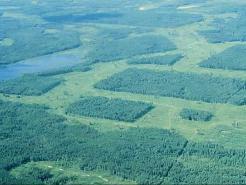 An exchange on Alert-Conservation.org over the intactness of boreal forests has just erupted. Bill Laurance asked me to weigh in as an independent appraiser of the debate, so I copy my thoughts below. You can read the original exchange between Jeff Wells and Nick Haddad (& colleagues) here.
An exchange on Alert-Conservation.org over the intactness of boreal forests has just erupted. Bill Laurance asked me to weigh in as an independent appraiser of the debate, so I copy my thoughts below. You can read the original exchange between Jeff Wells and Nick Haddad (& colleagues) here.
—
Despite its immense size, there is little doubt that the ugly second cousin of forest conservation is the boreal region covering much of Alaska, Canada, Fennoscandia and Russia. Indeed, extending some 1.4 billion hectares, of which well over 60% is found in Russia alone (1, 2), the entirety of the boreal forest is more than double the area of the Amazon forest. Yet despite this massive expanse, the impressive biota it shelters (2), and its important contribution to the global carbon (1), nitrogen (3) and oxygen (4) cycles, the boreal is an oft-overlooked region in terms of global conservation priorities and possibilities (5).
The exchange between Haddad & Sexton and Wells regarding the former researchers’ recent paper (6) highlights this problem, of which even many expert ecologists are often only vaguely aware. Wells takes particular issue with Haddad and colleagues’ assertion that the boreal forest is highly fragmented, claiming to the contrary that the (North America) boreal forest is “… truly intact … ”. While Haddad et al. respond that they did not differentiate between ‘natural’ and human-caused fragmentation, my view is that the exchange misses some important concerns about the state of the boreal forest.
Wells correctly points out that the boreal zone in North America is “massive”, but can his other claim – that it is “truly intact” – stand up to scrutiny? Citing one of my own papers from 2009 (2) to demonstrate (correctly) that the boreal forest of North America holds a stunning array of species, Wells neglects to highlight that in that same paper we also identified the extensive, artificial fragmentation that has occurred there and in other parts of the boreal zone over the last few decades. For example, we showed clearly that only 44% of the entire biome is considered to be ‘intact’, defining the term precisely as “areas ≥ 500 km2, internally undivided by infrastructure (e.g., roads) and with linear dimensions ≥ 10 km”. Satellite imagery has also confirmed that between 2000 and 2005, the boreal biome experienced the largest area of gross forest cover loss compared to any other (7). Despite recent evidence that so-called edge effects (characteristics of a disturbed matrix that penetrate some distance into habitat fragments) are probably of a smaller spatial magnitude in boreal compared to other biomes (8), it is disingenuous to claim that North America’s boreal forests are “truly intact”.
This perspective also ignores the intense historical and current fragmentation to the largest boreal forest region in Russia. Between 1988 and 1993, Russia lost an average of 1.1 million hectares of forest per year due principally to logging, and an increase in fire and insect outbreaks due to direct (fire) and indirect (climate-driven insect outbreaks) human pressures has eroded the area even further (2). Add these observations to the evidence mounting that the boreal forest has already or is about to become a net carbon source due to direct (logging, fire) and indirect (climate change, insect outbreaks) human influences (1), it is counter-productive in any conservation sense to purport that the boreal zone is anything but a highly modified and increasingly disturbed biome.
I can understand that anyone used to the images of forest devastation from South East Asia, the Amazon or many parts of Central Africa might be convinced that the boreal forest is comparatively intact – for it is indeed relatively more contiguous. However, the extent of the boreal fracturing can be easily missed if not observed from broader spatial scales. From my own personal experience in the boreal forests of northern Alberta over 20 years ago, the sight of a vast expanses of boreal forest criss-crossed with seismic exploration lines and clearcuts from logging testify viscerally to our capacity to modify even the seemingly infinite spans of remote boreal wilderness. While the boreal forest might not have the same human population densities or experience the same degree of legal and illegal forest conversion as the tropics, it is nonetheless a highly and increasingly stressed ecosystem. Fortunately, we still do have the opportunity to limit the worst ravages that deforestation, climate change and fire could wreak there (5), but we have to get a lot more serious about measuring, recognising and limiting the damage we as a society seem so desperate to accomplish.
- Bradshaw CJA & Warkentin IG (2015) Global estimates of boreal forest carbon stocks and flux. Global and Planetary Change 128:24-30.
- Bradshaw CJA, Warkentin IG, & Sodhi NS (2009) Urgent preservation of boreal carbon stocks and biodiversity. Trends in Ecology and Evolution 24:541-548.
- Vitousek PM, et al. (1997) Human alteration of the global nitrogen cycle: sources and consequences. Ecological Applications 7:737-750.
- Angert A, et al. (2003) Contribution of soil respiration in tropical, temperate, and boreal forests to the 18O enrichment of atmospheric O2. Global Biogeochemical Cycles 17:1089.
- Moen J, et al. (2014) Eye on the taiga: removing global policy impediments to safeguard the boreal forest. Conservation Letters 7:408-418.
- Haddad NM, et al. (2015) Habitat fragmentation and its lasting impact on Earth’s ecosystems. Science Advances 1:e1500052.
- Hansen MC, Stehman SV, & Potapov PV (2010) Quantification of global gross forest cover loss. Proceedings of the National Academy of Sciences of the USA 107:8650-8655.
- Harper KA, et al. (2015) Edge influence on vegetation at natural and anthropogenic edges of boreal forests in Canada and Fennoscandia. Journal of Ecology doi:10.1111/1365-2745.12398.

